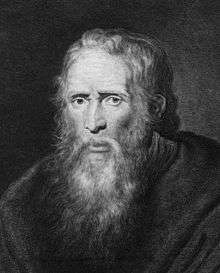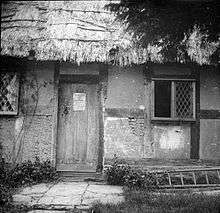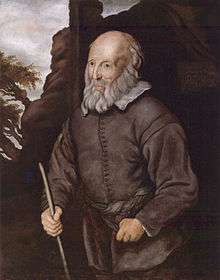Old Tom Parr

Thomas Parr (died 14 November 1635) was an Englishman who was said to have lived for 150 years.[1] He is often referred to simply as Old Parr or Old Tom Parr.
A portrait of Parr hangs at Shrewsbury Museum and Art Gallery, with an inscription which reads “Thomas Parr died at the age of 152 years 9 months” “The old old very old man or Thos Parr son of John Parr of Winington in the Parish of Alberbury who was borne in the year 1483 in Rayne of King Edward IV being 152 yeares old in the year 1635”. The portrait was once in the collection of the Leighton family of Loton Park, which is in Parr's home parish of Alberbury.[2]
Biography

Records vary, but Parr was allegedly born around 1483 in the parish of Alberbury, Shropshire. He had two children, both of whom died in infancy. He existed and even thrived on a diet of “subrancid cheese and milk in every form, coarse and hard bread and small drink, generally sour whey”, as William Harvey wrote. … "On this sorry fare, but living in his home, free from care, did this poor man attain to such length of days".
Parr purportedly had an affair when he was over 100 years old and fathered a child born out of wedlock. After the death of his first wife, he married his child's mother at the alleged age of 122.[3]
As news of his reported age spread, 'Old Parr' became a national celebrity and was painted by Rubens and Van Dyck. In 1635, Thomas Howard, 21st Earl of Arundel, visited Parr and brought him to London to meet King Charles I. Charles asked what Parr had done that was greater than any other man, and the latter replied that he had performed penance (for his affair) at the age of 100.
Parr was treated as a spectacle in London, but the change in food and environment apparently led to his death. The king arranged for him to be buried in Westminster Abbey on 15 November 1635.[1] The inscription of his gravestone reads:
THO: PARR OF YE COUNTY OF SALLOP. BORNE
IN AD: 1483. HE LIVED IN YE REIGNES OF TEN
PRINCES VIZ: K.ED.4. K.ED.5. K.RICH.3.
K.HEN.7. K.HEN.8. K.EDW.6. Q.MA. Q.ELIZ
K.JA. & K. CHARLES. AGED 152 YEARES.
& WAS BURYED HERE NOVEMB. 15. 1635.
Doubts of his age

William Harvey (1578–1657), the physician who discovered the circulation of the blood,[4] performed a post-mortem on Parr's body.[5][6] The results were published in the book De ortu et natura sanguinis by John Betts as an attachment. He examined his body and found all his internal organs to be in a perfect state. No apparent cause of death could be determined, and it was assumed that Old Parr had simply died of overexposure. A modern interpretation of the results of the autopsy suggests that Thomas Parr was probably under 70 years of age.[7] A monument to him was erected at Westminster Abbey.
It is possible that Parr's records were confused with those of his grandfather. Parr did not claim to remember specific events from the 15th century.[6]
Cultural references
- John Taylor wrote about Parr in his poem of 1635 The Old, Old, Very Old Man, or the Age and Long Life of Thomas Parr.[8]
- A portrait of Parr hangs in the National Portrait Gallery, London.[9]
- Old Parr is mentioned in Dickens's Dombey and Son, chapter 41, and also in his The Old Curiosity Shop, Chapter The Last. A pony who lives an unusually long life is compared to Parr.
- Parr's old age is mentioned in the book Walden, by Henry David Thoreau.
- Mark Twain, in 1871, "proposed writing 'An Autobiography of Old Parr, the gentleman who lived to be 153 years old' but apparently never did so."[10]
- Bram Stoker makes a reference to Thomas Parr in Dracula.
- Old Parr is referred to in the opening page of James Joyce's novel Finnegans Wake (1939).[11]
- His story was featured on the TV show Beyond Belief!! on the American network Nickelodeon in 1992.
- The Scotch whisky brand Grand Old Parr is named after him and recounts his claimed birth and death years on its label.[12]
- Parr has been used as an example of the supposed health benefits of some natural medicines, including herbal colon cleansing.
- In the film The Champ (1979), a small statue of Parr instigates a conversation between a boy and his stepfather.
- Parr is named in Time Enough for Love by Robert A. Heinlein.
- Old Parr is mentioned in Robert Graves's poem A Country Mansion.
- In Hammersmith, London, there is a pub named "The Old Parrs Head".
- In Patrick O'Brian's The Surgeon's Mate, Stephen Maturin uses Old Parr as an example to encourage an aged friend contemplating marriage
- Margaret George's novel Elizabeth I imagines a meeting between Old Parr and the Queen.
- Elizabeth Hobbs's animation film "The Old, Old, Very Old Man"
References
- 1 2 Information from Westminster Abbey on Parr's life, including the inscription on his gravestone. Retrieved on 10 January 2008
- ↑ Shropshire Museums. "Darwin Country". Retrieved 5 May 2013.
- ↑ Pine, L. G. (July 1965). "Thomas Parr – the most long-lived Englishman". Shropshire Magazine. Famous Shropshire sons – no. 5. 17 (5): 26–7.
- ↑ William Harvey San José State University. Retrieved on: 10 January 2008
- ↑ William Harvey and the anatomo-pathological dissection or Thomas Parr PubMed.gov Retrieved on: 10 January 2008
- 1 2 Thomas Parr NNDb.com Retrieved on: 15 March 2011
- ↑ P. Lüth “Geschichte der Geriatrie” (1965), S. 153 + 154
- ↑ THE OLD, OLD, VERY OLD MAN; Or the Age and Long Life of Thomas Parr AntiQbook.com Retrieved on: 10 January 2008
- ↑ Sir Peter Paul Rubens. "Portrait of Thomas Parr". The National Portrait Gallery. Retrieved 28 December 2007.
- ↑ Autobiography of Mark Twain, volume 1, p. 5
- ↑ "Oldparr". FinnegansWiki.
- ↑ The Life and Times of Thomas Parr. northstar-website-design.com